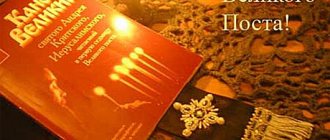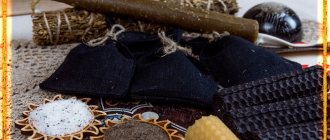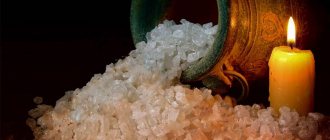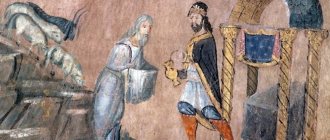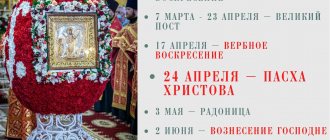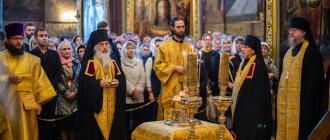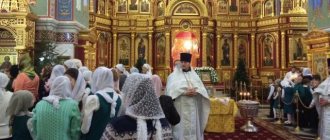Each day of the last week of Lent has its own meaning. But among them there is one that is filled with a special meaning. Maundy Thursday (Clean, Holy, Great Thursday) - Thursday of Holy Week, when the Last Supper is remembered, at which Jesus Christ established the sacrament of the Eucharist (Holy Communion) and washed the feet of the disciples, as well as his prayer in the Garden of Gethsemane and the betrayal of Judas.
Why is Maundy Thursday called clean?
This is the popular name for the day. It is based:
- at the remembered Gospel event, when the Lord washed the disciples’ feet;
- on the fact that from ancient times two interconnected sequences were performed: the washing of the throne (which was a symbol of the preparation of the Apostles for the Supper) and the Rite of washing the feet - a literal reproduction of the event described in the Gospel;
- on the ancient practice of performing the sin-washing Sacrament of Baptism on Maundy Thursday;
- based on the established tradition, to approach the Eucharist as soon as possible for a Christian .
Interesting fact
Until 1917, in most cities of Orthodox Russia, Maundy Thursday, like the entire Holy Week, was free from work - so that people could talk and receive communion. Now Christians try to attend services whenever possible, since the day is considered a weekday, a working day.
It is from liturgical practice that later traditions of this day come - for example, cleaning the house before Easter. However, it is not important in itself: it’s just that a person who has cleansed his soul through Repentance and Communion would naturally want to see his home clean as well.
Washing the feet
Washing with silverware
If you use silver water on Maundy Thursday, you don’t have to be afraid of evil spirits and enemies. The night before the event, an object made of pure silver was placed in a bowl of water, and the face was washed in the morning.
Old people in the villages said that this tradition is useful for babies, who especially need protection. When washing, people uttered the phrase: “I wash away what they put on me, what is toiling my soul and body, everything is removed on Maundy Thursday.”
This is interesting! Many peoples consider silver water to be unusual - it does not go bad for a long time, and food cooked with it seems tastier.
What events do we remember on Maundy (Maundy) Thursday?
They are described by all the Gospel writers, although with varying degrees of detail:
- the last meal of Jesus Christ with his disciples; It was already known that the Jews were looking for the Lord to betray the Roman authorities, so a small community of His disciples gathered secretly; hence the name of the meal, the Last Supper;
- the last conversation of the Lord with the Apostles;
- the prayer of Jesus in Gethsemane, the last hours before His arrest;
- the capture of the Lord by the Jews, the trial by the high priests, then by Pilate.
Vasily Petrovich Vereshchagin. "Prayer for the Cup."
Last Supper
This is the event on which the attention of all four Evangelists , since the main Christian Sacrament - the Eucharist - is established here.
Place
It is known that to prepare the Supper, the Lord sent two disciples, warning them to turn to “the man carrying a pitcher of water.” Many interpreters believe that this could be a conventional sign, and that the owner of the house himself could be one of the admirers of Jesus.
The house stood on Mount Zion, it has survived (in a rebuilt form) to this day, belongs to the state and is open to the public. Over the centuries, it was owned by both Christians (Catholics) and Muslims.
The Upper Room of Zion is a special place where, in addition to the Memorial, the following also took place:
- the appearance of Christ to the disciples after the Resurrection;
- election as Apostle St. Matthias;
- Descent of the Spirit on the Apostles;
- there is a possibility that the first Apostolic Council was held here (around 42)
Last meal time
The holy fathers also drew attention to the fact that the Evangelists have different information about this:
- St. Matthew , Mark, Luke report that it took place on “the day of unleavened bread, when the Passover lamb was to be slain” (Luke 2:27), thus we are talking about the Jewish Passover, which the Lord celebrated, since “not to be broken... the Law has come , but to fulfill” (Matt. 5:17);
- and St. John the Theologian says that the supper took place before the celebration of Passover.
Some see a contradiction between Evangelists here. However, it is apparent. St. John clearly says that the Passover of the year in which the Savior suffered fell on Saturday - a day of rest, when any work was strictly prohibited. According to tradition, “inaction” began already on Friday evening, so the slaughter of the lamb was possible only a day earlier, that is, on Thursday, which was the “first day of unleavened bread.” Thus, we are really talking about the fact that the Lord and His Apostles gathered for a festive supper - the Seder.
Feat of humility
This episode is mentioned by one St. John: Before the meal began, the Lord did something strange. Having taken off his outer clothing, He, like a servant, washed the feet of each of the Apostles, kneeling before him. John the Theologian writes that Peter, the most zealous and ardent, could not stand the humiliation of the Teacher:
"God! Should you wash my feet?
(John 13:6).
And he receives the answer - that the meaning of the event will be understood “after”.
However, it was immediately clear to one of the twelve - Judas, who had already agreed with the high priests when and where he would betray the Teacher to them. The Rabbi knew about this, and the practically former Apostle understood that Jesus knew. If only because Christ said it directly more than once.
His self-denial was an attempt to reach Judas, to show that his repentance could be accepted at any second, for the Lord loves him - no matter what.
It is no coincidence that immediately after washing His feet He was “troubled in spirit,” grieving over the traitorous disciple:
“And he bore witness, and said, Verily, verily, I say unto you, that one of you shall betray Me.”
(John 13:21).
The Lord will not tell the disciples until the end who the traitor is - of course, they would have immediately stopped Judas. But Christ waited until the last minute to see if the traitor’s heart would change.
Now the Church mournfully sings:
“When the glory of the disciple is enlightened at the thought of the supper, then the evil Judas, sickened by the love of money, becomes darkened, and betrays the righteous Judge to the lawless judges. See, the steward of the estate, who used strangulation for these sake! Flee the unsatiated soul, such a teacher who has dared: Who is good of all, O Lord, glory to Thee.”
And every Christian before Communion repeats: “... I will not kiss You like Judas...” , testifying to his sincerity.
last supper
What did you eat during your last meal?
This is indicated by many details contained in the Gospels, which were quite understandable to the Jews of that time:
- “salted”, where Christ dips the bread - a ritual bowl of salted water, an indispensable attribute of the festive table; it symbolized the tears shed by the Jewish people in Egypt;
- on the table there was also a dish with herbs - garlic, onions, horseradish, chicory; they also symbolized the bitterness of the people who were persecuted by the Egyptian pharaoh;
- there was also a paste made from nuts, pomegranates, dates - its reddish color was reminiscent of the clay of the bricks that the Jews made in slavery;
- obligatory attributes were unleavened bread (that is, not made with leaven, just a mixture of flour and water) bread - now known as matzo - and wine diluted with water - four cups;
- finally, there was also sacrificial lamb meat on the table; he was usually slaughtered in the temple courtyard after 12 noon; at the same time, the blood of the lamb was accepted by the priests and poured out at the foot of the altar; then the meat was fried over the fire at home.
The course of the Passover ritual meal itself should have looked like this:
- after the prayer, the elder at the table took the first cup of wine, offered it with thanksgiving to God, and then passed it around to everyone present;
- then the younger member of the family had to ask the ritual question: “What does all this mean?”; followed by a story about the exodus of the Jews from Egypt, psalms were sung; everyone ate bitter herbs until tears appeared in their eyes, similar to those that the Israelites shed;
- after the second cup raised with prayer, the elder at the meal blessed the unleavened bread; dividing them among everyone;
It was at this moment, obviously, ap. John asked the Teacher who was His traitor. Many are perplexed - why didn’t the Apostles recognize him, since the Lord, having said that this was the one who accepted bread from His hands, immediately gave a piece to Judas? Meanwhile, everything is simple: because the Lord gave bread to everyone. In other words, He did not answer the question of the beloved disciple. Or maybe he answered. Didn’t His disciples betray Him by fleeing after being arrested?
- then the family consumed the lamb, after which the third and fourth bowls followed in a circle, which completed the meal; everyone went out into the street, praising God with songs.
At first glance, the description of the Last Supper of the disciples of Christ is to some extent indeed similar to the “Seder Pesach”. However, none of the Evangelists mention the main part of the seder, the lamb. The Apostles also do not say a word that any of them went that day to the Jerusalem Temple to slaughter a sacrifice.
Last Supper. Fresco from 1312. Catholicon of Vatopedi Monastery. Athos
Thus, it is clear that the main Passover tradition of the lamb has been broken. Or is it still fulfilled?
Eucharist
The shortest but most succinct answer about the reason for the absence of the “most important thing” at the “Seder” of the Apostles is given by St. Paul, by the way, did not attend the Last Supper, for his appeal to the Lord happened much later:
“Our Easter, Christ, was sacrificed for us”
(1 Cor. 5:7).
Apparently, after the second cup, Jesus, instead of the ritual words of blessing the bread (or maybe after them), says completely different ones:
“...this is My Body, which is given for you”
(Luke 22:19).
And then, in a completely different way than is customary, the words of the blessing of the cup of wine sound:
“Drink of it, all of you, for this is My Blood of the New Testament, which is shed for many for the remission of sins.”
(Matt. 26, 27-28).
Now these words are pronounced by the priest who is performing the main Sacrament - the transfusion of bread and wine into the Body and Blood of the Savior, which first took place during that Last Supper.
“What does all this mean?”
But then the Apostles still do not understand what “Blood of the New Testament” means and why the custom was violated. They do not realize that the Paschal Lamb is the Lord Himself, giving his life for people.
So the question: “What does all this mean?”, and not a ritual one, could follow after the end of the meal itself. Because further, instead of telling how the Apostles left the house singing songs, as was customary, the Evangelists cite the words of Christ’s conversation with them. According to St. Mark, Matthew, Luke, He says to them:
- about His future suffering;
- warns of coming severe temptations - tests of their faith (“I will strike the shepherd, and the sheep will be scattered”), which they cannot withstand without God’s help.
Three of the four authors of the Gospels write about how zealously the disciples rejected the very possibility of renouncing Him, especially Peter (this would happen to him in a few hours!), how they were ready to defend Him with weapons, how depressing Christ was by their lack of understanding of what was happening. His words are filled with sorrow about the weakness of people who think only about earthly things: “Enough is enough,” “Get up, let’s get out of here.” That is, it is useless to explain anything...
Only the beloved disciple of Christ, St. John the Theologian preserved much more of the words of Jesus spoken by Him in those last hours before being taken to be tortured. By the way, John was the youngest of the disciples. The fact that it is his Gospel that contains the most detailed answer to the question “What does all this mean?” - can be considered symbolic.
New commandment
The words of the Lord, which have come to us thanks to the Gospel of St. John the Evangelist, they say:
- about the coming glory of the Son of Man;
- about the future Descent of the Holy Spirit;
- but the most important thing that the Savior says to the Apostles, frightened by His words about impending humiliation and execution, is that He goes to death out of love for people.
Imitating Him in love - for God, for people - is the shortest path to the Kingdom of Heaven. Jesus repeats over and over again:
“As the Father has loved Me, I have loved you; abide in My love. If you keep My commandments, you will abide in My love, just as I have kept My Father’s commandments and abide in His love... This is My commandment, that you love one another, as I have loved you. Greater love has no one than this, that someone lay down his life for his friends... This I command you, that you love one another...” (John 15).
At that moment they will not understand - in a few hours the zealous Peter will draw his sword in defense of the Rabbi. He will be completely lost - when the Lord heals the slave he wounded, he himself will surrender to the tormentors.
Artist Fra Beato Angelico
Later, after the Resurrection, the Ascension, when the Holy Spirit overshadows the disciples, they will understand God’s love, become Her chosen vessels, and by their example and prayer they will try to help others achieve this measure. And for many of us, a lifetime is not enough to get to the essence of the Lord’s words.
Coming Sacrifice
The fulfillment of the destined was approaching. Following the Jewish tradition, Christ and his disciples “singed and went to the Mount of Olives” (Mark 14:26). This, as the Evangelists unanimously point out, was the favorite meeting place of the community of Jesus' disciples. And now the Lord, having taken with him the chosen Apostles who had seen His Transfiguration, departed from the rest for solitary prayer.
In our time, in the place where the words of the Lord addressed to the Father were heard, there is a basilica belonging to Catholics. And not far away is the “Cave of the Disciples,” according to Western Christian tradition called the “Cave of Betrayal.”
Cave of Betrayal
After all, the faithful followers of Jesus, who had recently vowed to die for Him... fell asleep. Through their slumber it reached them:
“Oh, if You would deign to carry this cup past Me... Thy will be done...”
And then the dream disappeared at once: the Teacher stood nearby, collected, calm:
“Are you still sleeping and resting? It is finished, the hour has come: behold, the Son of Man is delivered into the hands of sinners” (Mark 14:41).
An excited crowd, led by one of the Apostles, was already approaching Gethsemane...
Tradition of Christ
This is the last event remembered on Maundy Thursday. People who came out “like a robber” to the unarmed Teacher, His calm words:
- It's me,
from which the Jews for some reason fell to the ground - at once remembering that in front of them was the Wonderworker, the prophet. He could still have left, but he didn’t.
Emboldened, they took Him, tied Him up, and delivered Him to the high priests. False accusations, whose untruth is obvious, nervous Annas and Caiaphas, realizing that now the accusation will fall apart - and then the question:
-Are you Christ?
And His only answer, who had been silent until now, was affirmative. Now He, who declared Himself God, can be executed according to the Law - but the Jews under the rule of Rome do not have the right to do this. So Christ finds himself before “Hegemon Pilate,” the ruler. His path to the Cross begins.
N. N. Ge “What is truth?” Christ and Pilate. 1890 Oil on canvas. 233 × 171 cm State Tretyakov Gallery, Moscow
On the evening of Maundy Thursday, believers who experienced the Last Supper with the Lord come to read the 12 Gospels of the Passion - to be with Him during these last hours on earth.
Main liturgy of the year
Ilya Krasovitsky, senior lecturer at the Department of Practical Theology of PSTGU:
– Holy Thursday is the memory of the Last Supper. That event that took place at night from Thursday to Friday of the last earthly days of Christ.
The Last Supper is the Easter meal of Christ with his disciples. The Lord preached all day in the Jerusalem temple, and in the evening there was a Passover meal. The Gospel readings for Holy Thursday describe the events of the Last Supper.
Since then, Christians have been gathering together to thank God for His sacrifice made “for the life of the world” from the Nativity, the torment of the cross and the crucifixion, who conquered death by death and was resurrected. And it is to this fullness of Christ, to Christ who suffers, dies and rises that we partake in the sacrament of the Eucharist.
The Evangelist John writes in more detail about the Last Supper. He records the entire long conversation of Christ with his disciples and describes the washing of feet.
Evangelist Luke also introduces elements of the conversation that are not found in other Evangelists. App. Matthew and Mark describe in detail the main thing that happened, namely the establishment of the Eucharist.
Fra Beato Angelico, The Last Supper; fresco of the monastery of San Marco, Florence, con. 15th century. Image from dic.academic.ru
After the Last Supper ended, the Lord and his disciples went to the Garden of Gethsemane, and there He prayed until he sweated blood.
Christ did not hide the fact that it was important for Him to be with friends at that hour; He was not embarrassed that they would hear words about not drinking the cup of His suffering. He took Peter, James and John with him and asked them to watch with Him.
But the disciples could not stand it and “fell asleep,” as one of the evangelists says, “out of sadness.” Christ was left alone and prayed to the Father, and in this prayer he suffered for humanity and feared the crucifixion and death of his loved ones, but His last words were: “Not my will, but Yours, be done.”
This is a night time event. For Holy Week there is no clear separation of one day from another. Events flow into each other in a continuous stream.
There are many customs in the Church associated with Maundy Thursday. For example, the consecration of the world, the preparation of reserve Gifts; previously, the washing of the throne was also performed.
Why are so many traditions associated with this Liturgy? Because this is the main Liturgy of the year, the remembrance of the very establishment of the Sacrament of the Eucharist.
“The Lord’s Prayer for the Apostles and for the Church” (John 17: 1 – 26). Miniature from the Gospel and the Apostle, 11th century. Parchment. Monastery of Dionysiatus, Athos (Greece). Image from iconandlight.wordpress.com
Features of worship and prayer
First of all, the services of this day are longer than usual. The Liturgy (of St. Basil the Great) is combined with Vespers.
Besides:
- at the service, hymns of the day are sung, dedicated to the Last Supper, the betrayal of Judas;
- reading Scripture connects the story of the Last Supper of all the Evangelists;
- Perhaps the main thing that not only distinguishes Maundy Thursday, but shakes to the core of the soul everyone who comes to the service of this day - during the liturgy, instead of the Cherubic song, a prayer is sung, which every Christian reads before Communion:
“Today, O Son of God, accept me as a partaker of Your secret Supper: I will not tell Your secret to Your enemies, nor will I kiss You like Judas, but like a thief I will confess You: remember me, O Lord, in Your kingdom.”
It is repeated many times by the choir during the Sacrament itself. The line of communicants moves quietly, knowing well: the liturgy of this day is only called “Memory of the Last Supper.” In fact, this is the Last Supper, to which everyone is made a participant.
Washing your feet. Photo by the press service of the Udmurt and Izhevsk Metropolis
How is the Rite of Washing the Feet performed today?
It is also called a “liturgical action”, because it is not so much a prayer as a literal reproduction “in person” of this episode of the Last Supper.
Interesting fact
Until the middle of the 17th century. “actions”, as if immersing believers in Sacred history, were an integral (and beloved by the people) part of the divine service. For example, at the Entry of the Lord into Jerusalem, the Patriarch performed the so-called “Procession on a Donkey,” which reproduced the event described by the Evangelists.
In the XVI-XVII centuries. The beginning of the Rite was considered to be the washing of the throne, which took place in the altar - just as the Apostles prepared the upper room for the Supper. Nowadays this special sequence is not performed, so the Chin looks like this:
- at the end of the liturgy, 12 priests - representing the Apostles - emerge from the altar;
- during the deacon’s continuous reading of the words of the Gospel of John, the bishop - be it the Patriarch or the bishop - himself takes off his liturgical vestments, just as Christ once took off “His robe”;
- then he washes the feet of each of the seated priests; According to tradition, the words spoken by Peter are pronounced by the eldest of them.
The rank has been known at least since the 10th century, and came to Russia from Byzantium. Here it was performed until the middle of the 17th century, only in cathedral churches. Its revival dates back to April 16, 2009, when Patriarch Kirill performed the rite for the first time in many decades.
What is Holy Week
Maundy Thursday is in the middle of Holy Week, the last week of Lent. This period is the most important for believers. This week we must gather our last strength and adequately prepare for the Feast of Holidays.
When it passes
Lent occurs once a year.
This concept includes:
- Holy Pentecost;
- Lazarus Saturday;
- Palm Sunday;
- Holy Week.
The Holy Pentecost begins the fast and lasts for forty days, hence its name. It includes a full five weeks and an incomplete sixth. Saturday this week is called “Lazarus”, and Sunday is called “Palm”. On Lazarus Saturday, we remember the resurrection of Lazarus by Christ, who lay in the tomb for four days after his death (Gospel of John, chapter 11). Palm Sunday is otherwise called “The Entry of the Lord into Jerusalem” (Gospel of Matthew, chapter 21). On this day we remember how Christ entered Jerusalem in order to die on the Cross.
Holy Week is not included in the Holy Pentecost; it ends the period of fasting. This is the last week of abstinence, preparation for the Bright Feast of Easter. It occurs in the spring, but begins every year on different days depending on the day of Easter. In 2022, Passion Day will begin on April 22.
What is it for?
The entire Great Lent is aimed at cleansing the soul and body and preparing for the celebration of the Bright Resurrection of Christ. To do this, Orthodox Christians fast with soul and body and pray for forty days.
The main goal of fasting is not to limit oneself from eating savory food (meat, dairy, eggs) or even to limit oneself from carnal pleasures.
The main tasks of the post are:
- clarification of feelings;
- purification of thoughts:
- getting rid of passions;
- and as a result - drawing closer to God.
The highest desire of a true believer is not to find peace or improvement (as is the case with representatives of other religions), but to be united in spirit with Christ. This is our goal, which is achieved, of course, only through prayer and fasting.
Passion serves as the end of the fast; during it, believers are invited to strengthen their physical and mental fast:
- During these mournful days, we must try to limit ourselves from vain affairs and thoughts, spending time on the Internet and in front of the TV screen, pray more, and visit churches more often.
- It is important not to judge anyone, not to quarrel with anyone, not to hold grudges. But we must, on the contrary, humble ourselves in front of everyone, forgive the offenders, without wanting them to be punished.
- It is very important to reconcile on these holy days with those with whom you were in a quarrel.
- During Passion, Orthodox believers must remain silent and be transported in mind and heart to the distant time of the earthly life of Our Savior, remember His suffering, sympathize with Him in torment, and grieve in soul. After all, He endured all this torment solely for our sake, atonement for our sins. Therefore, believers must show mutual love for God in these sorrowful days.
Traditions and rituals
Since ancient times in Rus' during Passion there have been certain traditions. Each day of this week has its own custom.
Holy Week in Rus' had different names:
- Red;
- Holy;
- Great;
- Chervonaya.
In Ukraine it was called “Biliy Tizhden”, “Chisty Tizhden”. In Belarus - “Rusal Week” (it was believed that during the Holy Day, evil spirits go on a rampage). All nations were actively preparing their homes for the holiday these days. They washed walls, benches, floors, tables, windows, etc. They whitewashed walls and stoves, knocked out rugs.
Starting on Thursday, they began to prepare Easter dishes:
- paint eggs;
- bake Easter cakes;
- make cottage cheese Easter.
The streets were quiet during these fasting days; there were no gatherings, round dances, or festivities. Specially appointed people kept order.
According to some beliefs, in the last days of Great Week the departed return to earth, where they remain until Easter.
The meaning of the Great Week
For every believer, the days of this week are a special time during which strict fasting is observed and preparations are underway for the Bright Day. For a long time, it was considered a sin not only to eat lean food, but also to eat a lot of lean food. Some even abstained from food completely during these days. Singing songs, empty talk, and condemnation were also considered sins. Under no circumstances should you visit or have fun on Holy Day.
The days of Great Week are the result of Great Lent, a time of special abstinence and sorrow, preparing the soul for the meeting with the Risen Christ.
Since ancient times, people have often attended divine services, received the Holy Mysteries of Christ, and cleansed their souls with repentance during Holy Week.
What you can and cannot do on Maundy Thursday
Unfortunately, some, especially new Christians, reduce the great day only to prohibitions or permissions. In addition, there are many signs, superstitions, and folk customs, not all of which can be called truly Christian.
Participle
What is “Thursday salt” and what to do with it?
According to ethnographers, Russian peasants made this salt by burning ordinary table salt in the oven on Maundy Thursday. And in some places they simply carried out salt “under the stars” on Thursday night, because they, too, were consecrated on this great day. The salt was kept until the next year, it was credited with healing powers, and blessed eggs were also sprinkled on Easter. Here it is difficult to separate the Christian desire to sanctify every step with God's blessing from pagan ideas about the magical power of salt.
Is it worth making such salt now, reviving semi-pagan customs? Perhaps this time would be better spent on worship and prayer.
Is it necessary to wash and clean the house?
No. The main thing is to be present at the service. Cleaning before Easter, which, of course, is not only not sinful, but even necessary, is still done to the extent possible. The same applies to your own cleanliness - it is necessary, but it is hardly worth washing for superstitious reasons. Modern pastors advise, first of all, to avoid vanity.
Traditions, customs and signs
Among those, dating back to paganism, preserved by Russian peasants until the end of the 19th century:
- “Thursday water”, collected by the owner of the house from a river or stream; it was considered healing, and also... for some reason “attracting” wealth to the house;
- residents of the North and Siberia literally created a smoke screen: they burned juniper branches right in the hut for the sake of purification; all the household stepped over the fire; It is worthy of surprise that Christians, for the sake of pagan superstition, exposed not only their own homes, but the homes of their neighbors to the danger of fire; this aggravated the already serious problem of fires, which often burned down entire villages;
- the “Thursday candle” was revered everywhere; Nowadays Orthodox Christians also try to bring home a lamp lit from the candle with which they stood listening to the Passion Gospels on Thursday evening; but the superstitions of our ancestors went so far that if the candle went out on the way home, they believed that trouble would certainly happen to the person; however, there were many churches then, they were within walking distance (hence the word “parish”); How then should modern city dwellers, who travel an hour or even more to get to church, perceive the extinguished candle?
The harm of conspiracies
The Church treats them extremely negatively, especially if baptized Orthodox Christians engage in such foolishness. The warning of St. John fully applies to them. Paul, that
“It is impossible for those who were once enlightened, and have tasted the heavenly gift, and have become partakers of the Holy Spirit, and have tasted the good word of God and the powers of the world to come, and have fallen away, to again renew them to repentance, when they again crucify the Son of God within themselves and mock Him” (Heb. 6 :4-6). Truly, according to the words of Christ Himself, “the last thing for that person is worse than the first” (Matthew 12:42).
What do you do on Maundy Thursday?
So, Maundy Thursday is the time when you can (and should):
- visit the temple, liturgy, service of the 12 Gospels;
- proceed to Communion, the day before - to Confession;
- read Scripture, the works of the holy fathers, sermons of modern pastors dedicated to Holy Week.
It is forbidden:
- indulge in the bustle of life, worldly entertainment;
- offend, condemn (however, as on other days of the year);
- commit sacrilege, observing various kinds of traditions dating back to paganism.
“The Son of Man comes, as it is written about Him,” and every believer’s soul hurts about his own weakness, about how each of us, with our sins, crucifies His love again and again. Sometimes all we can do is walk with Him on the terrible Way of the Cross. At least close. Or even from afar. Just to go.
Natalia Sazonova
Rituals for love and marriage
Fortune tellers consider Thursday of Holy Week to be especially powerful for casting love spells.
Here are a few rituals:
- If you have Easter cakes ready at home, take one, grab it and go outside. When you see the first man you meet, ask him what his name is. It is believed that this way you can find out the name of your future husband.
- At dawn, go into the yard and hug the fence. Count how many boards fell into the embrace. If the number is even, you will find a groom this year.
- Wash your face before dark and say: “As Maundy Thursday is bright and red, so I, slave (name), will be the most beautiful for everyone. Amen". Then cross yourself 3 times. This ritual will help attract the attention of guys.
- After washing your face in the morning, dry yourself with a new towel. Take it with you to the church on the occasion of the Resurrection of Christ and serve it along with eggs or Easter cake to any of the poor people who always ask for alms at the entrance to the church. This ritual will help a woman get a husband faster.
- Buy good men's slippers. Say to them: “My betrothed, disguised, without bad habits, appear!” You can add a few points of your own that are important to you (most importantly, not a huge list). To ensure a happy marriage and for your husband to always be there, after casting the spell, carry the slippers with you for a while. When the right man comes along, give him these shoes.
Important note! You cannot perform rituals if you are on your period.
